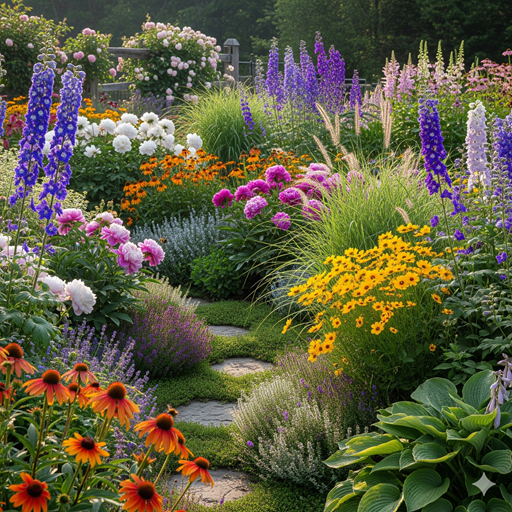Discover the best perennial plant combinations for your garden. Our guide covers design principles, cultivation tips, and pairings to help you create a beautiful, low-maintenance landscape.
What Blooms with What? Your Guide to Colorful Perennial Plant Combinations
Welcome, gardeners! Whether you are a seasoned green thumb or just starting your first flower bed, one of the biggest challenges is creating a garden that stays vibrant and eye-catching throughout the seasons. It is not just about what plants you choose, but how they work together. This guide will help you master the art of perennial pairings, ensuring your garden is a showstopper from spring through fall.
Foundational Principles: Beyond Just Pretty Flowers
Creating a successful perennial border is about more than just aesthetics. Consider these key factors for a thriving and beautiful garden:
- Understand Your USDA Hardiness Zone: The single most important factor for plant survival is your location. Plants are rated by their ability to withstand winter cold, and these ratings are based on the USDA Plant Hardiness Zone Map. Always check the zone rating for any plant you buy to ensure it will be a true perennial for your region.
- Balance Sun and Shade: Group plants with similar light requirements. A plant that needs full sun (6+ hours of direct light) will struggle in the shade, and a shade lover will scorch in full sun. Observe your garden throughout the day to identify your sunny and shady spots.
- Know Your Soil: Most perennials prefer loose, well-draining soil with a neutral to slightly acidic pH (6.0-7.0). Amend heavy clay soil with organic matter like compost to improve drainage. For plants that thrive in specific conditions, such as acid-loving astilbes or drought-tolerant yuccas, a soil test can provide valuable insight.
- Mix Forms and Textures: The most dynamic gardens feature a variety of plant shapes. Pair plants with spiky flower stalks (e.g., Veronica, Salvia) with those that have flat, rounded blooms (e.g., Coneflower, Shasta Daisy). Mix in plants with different foliage textures, from the feathery leaves of ferns to the bold, broad leaves of hostas.
Classic Perennial Plant Combinations for Every Garden Style
Here are some proven pairings that create stunning, reliable displays. Click on the plant names to shop our collection!
For Sun-Drenched Borders (6+ hours of sun):
- The Prairie Powerhouse: Coneflower (Echinacea purpurea) and Black-Eyed Susan (Rudbeckia hirta). These North American natives are a classic duo, providing continuous blooms from mid-summer into fall. They are incredibly heat- and drought-tolerant once established and are magnets for pollinators like bees and butterflies.
- The Modern Cottage Garden: 'Knock Out' Rose (Rosa) and Salvia (Salvia nemorosa). For a low-maintenance, high-impact pairing, plant shrub roses in drifts with a generous border of blue salvia. The vibrant pink roses and spiky blue flowers create a striking visual contrast and a long season of color.
- Drought-Tolerant Desert Bloom: Yucca (Yucca) and Asiatic Lily (Lilium). The architectural, spiky foliage of yucca provides a stunning structural element. Its tall, bell-shaped blooms are a perfect complement to the bright, cheerful cups of red or orange Asiatic lilies.
For Cool, Shady Retreats (Less than 4 hours of sun):
- The Shimmering Shade Border: Hosta (Hosta) and Astilbe (Astilbe). A match made in heaven for low-light areas. The varied foliage of hosta (from chartreuse to deep blue-green) provides a beautiful backdrop for the feathery, glowing plumes of astilbe.
- Elegant Woodland Duo: Cinnamon Fern (Osmundastrum cinnamomeum) and Foam Flower (Tiarella cordifolia). Create a sophisticated and restful space by combining the subtle textures of these plants. The tall, rust-colored fronds of the cinnamon fern stand out beautifully against a carpet of delicate, white-flowered foam flower.
- Native Woodland Charm: Trillium (Trillium) and Yellow Lady's Slipper (Cypripedium parviflorum). For those seeking to embrace native wildflowers, these early-blooming plants offer unique forms and colors. They thrive in rich, moist soil and provide a spirit-lifting display in early spring.
Advanced Cultivation Tips for the Experienced Gardener
For those looking to take their gardening to the next level, here are a few pro tips:
- Soil Testing is Key: Before amending your soil, get a professional soil test. It will tell you exactly what nutrients your soil is lacking and what its pH is, preventing you from over-fertilizing and saving you money.
- Timing is Everything with Pruning: Pruning schedules vary by plant. Deadheading spent flowers (like on salvia or coneflowers) encourages reblooming. Cutting back plants with diseased or insect-damaged foliage in the fall can prevent problems next year.
- Dividing for Vigor: Many perennials, such as hostas, daylilies, and asters, benefit from being divided every 3-5 years. This prevents overcrowding, revitalizes the plant, and gives you more plants to share!
Common Perennial Pests & Diseases
Do not let pests ruin your hard work. Here are a few common issues and how to manage them:
- Aphids: Tiny, soft-bodied insects that suck sap from new growth. A strong spray of water from a hose can knock them off, or you can use insecticidal soap.
- Powdery Mildew: A white, powdery fungus that covers leaves. It is often caused by poor air circulation. Ensure plants are properly spaced and avoid watering from above.
- Slugs and Snails: These mollusks leave slimy trails and chewed holes in hosta leaves. Hand-picking them in the evening or using slug bait can help control them.
- Japanese Beetles: These metallic-green beetles can skeletonize leaves. Hand-picking them in the morning is a good strategy for smaller infestations. Avoid beetle traps as they can attract more pests to your garden.
Build Your Living Bouquet
If you are still unsure what to plant, think about what flowers would make a beautiful bouquet. If perennial salvia, yellow gaillardia, and Shasta daisy look good in a vase, they will work together as a stunning living arrangement in your garden.
Ready to start? Explore our full selection of perennials and bring your dream garden to life.

